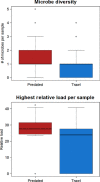Infectious disease, shifting climates, and opportunistic predators: cumulative factors potentially impacting wild salmon declines
- PMID: 25469162
- PMCID: PMC4227861
- DOI: 10.1111/eva.12164
Infectious disease, shifting climates, and opportunistic predators: cumulative factors potentially impacting wild salmon declines
Abstract
Emerging diseases are impacting animals under high-density culture, yet few studies assess their importance to wild populations. Microparasites selected for enhanced virulence in culture settings should be less successful maintaining infectivity in wild populations, as once the host dies, there are limited opportunities to infect new individuals. Instead, moderately virulent microparasites persisting for long periods across multiple environments are of greatest concern. Evolved resistance to endemic microparasites may reduce susceptibilities, but as barriers to microparasite distributions are weakened, and environments become more stressful, unexposed populations may be impacted and pathogenicity enhanced. We provide an overview of the evolutionary and ecological impacts of infectious diseases in wild salmon and suggest ways in which modern technologies can elucidate the microparasites of greatest potential import. We present four case studies that resolve microparasite impacts on adult salmon migration success, impact of river warming on microparasite replication, and infection status on susceptibility to predation. Future health of wild salmon must be considered in a holistic context that includes the cumulative or synergistic impacts of multiple stressors. These approaches will identify populations at greatest risk, critically needed to manage and potentially ameliorate the shifts in current or future trajectories of wild populations.
Keywords: climate; coevolution; cumulative impacts; ecological impacts; infectious disease; microparasite; predation; wild salmon.
Figures








Similar articles
-
Molecular indices of viral disease development in wild migrating salmon†.Conserv Physiol. 2017 Jun 27;5(1):cox036. doi: 10.1093/conphys/cox036. eCollection 2017. Conserv Physiol. 2017. PMID: 28702195 Free PMC article.
-
A survey of microparasites present in adult migrating Chinook salmon (Oncorhynchus tshawytscha) in south-western British Columbia determined by high-throughput quantitative polymerase chain reaction.J Fish Dis. 2017 Apr;40(4):453-477. doi: 10.1111/jfd.12607. Epub 2017 Feb 11. J Fish Dis. 2017. PMID: 28188649
-
Time to evolve? Potential evolutionary responses of fraser river sockeye salmon to climate change and effects on persistence.PLoS One. 2011;6(6):e20380. doi: 10.1371/journal.pone.0020380. Epub 2011 Jun 28. PLoS One. 2011. PMID: 21738573 Free PMC article.
-
An evaluation of the effects of conservation and fishery enhancement hatcheries on wild populations of salmon.Adv Mar Biol. 2007;53:61-194. doi: 10.1016/S0065-2881(07)53002-6. Adv Mar Biol. 2007. PMID: 17936136 Review.
-
The evolution and maintenance of virulence in microparasites.Emerg Infect Dis. 1996 Apr-Jun;2(2):93-102. doi: 10.3201/eid0202.960203. Emerg Infect Dis. 1996. PMID: 8903208 Free PMC article. Review.
Cited by
-
Infection dynamics and tissue tropism of Parvicapsula pseudobranchicola (Myxozoa: Myxosporea) in farmed Atlantic salmon (Salmo salar).Parasit Vectors. 2018 Jan 6;11(1):17. doi: 10.1186/s13071-017-2583-9. Parasit Vectors. 2018. PMID: 29306320 Free PMC article.
-
Molecular indices of viral disease development in wild migrating salmon†.Conserv Physiol. 2017 Jun 27;5(1):cox036. doi: 10.1093/conphys/cox036. eCollection 2017. Conserv Physiol. 2017. PMID: 28702195 Free PMC article.
-
Population-Specific Responses to Interspecific Competition in the Gut Microbiota of Two Atlantic Salmon (Salmo salar) Populations.Microb Ecol. 2018 Jan;75(1):140-151. doi: 10.1007/s00248-017-1035-6. Epub 2017 Jul 16. Microb Ecol. 2018. PMID: 28714057
-
Pathogens from salmon aquaculture in relation to conservation of wild Pacific salmon in Canada.Sci Adv. 2024 Oct 18;10(42):eadn7118. doi: 10.1126/sciadv.adn7118. Epub 2024 Oct 16. Sci Adv. 2024. PMID: 39413187 Free PMC article. Review.
-
Facing the river gauntlet: understanding the effects of fisheries capture and water temperature on the physiology of coho salmon.PLoS One. 2015 Apr 22;10(4):e0124023. doi: 10.1371/journal.pone.0124023. eCollection 2015. PLoS One. 2015. PMID: 25901952 Free PMC article.
References
-
- Actis LA, Tolmasky ME, Crosa JH. Vibriosis. In: Woo PTK, Bruno DW, editors. Fish Diseases and Disorders, Volume 3. Viral, Bacterial and Fungal Infections. Oxon, UK: CAB International; 1999. pp. 523–557.
-
- Aihua L. Buchmann K. Temperature- and salinity-dependent development of a Nordic strain of Ichthyophthirius multifiliis from rainbow trout. Journal of Applied Ichthyology. 2001;17:273–276.
-
- Alonso M, Saint-Jean SR. Pérez-Prieto SI. Virulence of Infectious hematopoietic necrosis virus and Infectious pancreatic necrosis virus coinfection in rainbow trout (Oncorhynchus mykiss) and nucleotide sequence analysis of the IHNV glycoprotein gene. Archives of Virology. 2003;148:1507–1521. - PubMed
-
- Altizer S, Harvell D. Friedle E. Rapid evolutionary dynamics and disease threats to biodiversity. Trends in Ecology and Evolution. 2003;18:589–596.
-
- Altizer S, Ostfeld RS, Johnson PTTJ, Kutz S. Harvell CD. Climate change and infectious diseases: from evidence to a predictive framework. Science. 2013;341:514–518. - PubMed
LinkOut - more resources
Full Text Sources
Other Literature Sources
Molecular Biology Databases

